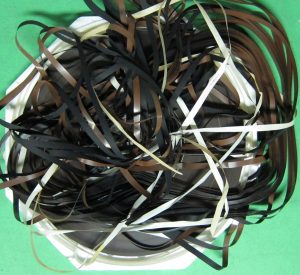Estimating Duration of Open Reel Audio
December 10, 2014
UPDATE: Find a simple Excel spreadsheet Duration Calculator here.
One of the biggest pains of trying to gain intellectual control over physical AV collections is determining the duration of open reel audio. Depending on recording speed, tape thickness, and track configuration, the same length of tape could at full capacity hold less than an hour of content or 24 hours of content.
Annotations or tape box labeling may document duration or some of these other determining characteristics, but in most collections I’ve worked with this notation is frequently missing or is unreliable due to the switching and reuse of boxes, and unlike most audiocassette and videocassette formats a total capacity for the item is not listed on the open reel box*. In that case, playback or the use of tools like a micrometer or Arnold magnetic viewer would at least give you clues to base estimates on, but those options are generally unavailable in most archives or are too time-consuming to rely on when processing collections or performing assessments.
Why does duration of audiotape matter? Two simple reasons if you’re going to be reformatting assets. First, content duration is a critical planning point for determining how long digitization will take. This will impact your budget and timeline whether you are doing work in-house our outsourcing. Longer tapes = more time and resources. Second, the length of the recording will impact file size and the amount of storage you will require, which may also factor into target format selection or the number of assets you will be able to digitize in a given time period.
The question is, then, does exact duration matter?
Short answer: No.
Longer answer: It depends.
It depends on the context of why you are collecting this data, but if you are digitizing you don’t necessarily need it. Exact duration (hh:mm:ss:ff) matters for broadcasting because there are exact times for starting programs, ending programs, and inserting commercials, and stations and broadcast servers rely on that data for scheduling and distribution.
Roughly exact time may matter for scheduling a screening, selecting materials for a class, or to determine if you have enough time to watch something before Zoomba class, but being off by seconds or a few minutes will not make or break things. Also, duration is not typically a primary data point one would use for search in a finding aid or catalog. It is secondary to descriptive factors and can be ballparked. (I know I have about 30 minutes so I will search for a TV show rather than a feature film.).
If planning for digitization, estimating duration is adequate (overestimating being better than underestimating). Nearly exact durations will give you better estimates, but as long as you are not severely underestimating you will not be in trouble. Longer tapes and shorter tapes will balance out, and you will hopefully come in under budget.
Whatever the case, ultimately the exact duration will be a part of the technical metadata in the file, and you will be able to extract it for use in your own database, thus decreasing the amount of hand data entry required.
How then does one estimate duration of open reel tapes? Depending on some of the known parameters of the collection, there are a few different options to consider or combine.
What is the content type?
You may not know the exact content, but you are more likely to know the content type. Are these radio programs? Commercials? Oral histories? Field recordings? Production materials from films? Ask yourself what would be the typical recording length for such content. A radio program is likely to be in 30 minute increments; oral histories may max out at 60-90 minutes; studio multi-tracks may only be one or two songs; sound for film production may correlate to the length of the film reel.
Who recorded this?
You may be able to make a reasonable guess based on provenance. Studio or professional recordings are more likely to be constant across recordings are more likely to have constant recording standards (same IPS, same track configuration, etc.) or use a faster recording speed (higher IPS) for higher quality. Amateur or field recordings may be more variable across recordings, or use a slower recording speed (lower IPS) to save space and fit more on the tape.
Physical Dimensions
While not always the most reliable indicator due to some of the previous factors, but when all else fails and where reasonable the reel dimensions are something to base an estimate on. Perhaps a 5-inch reel is 30 minutes, a 7-inch reel 60 minutes, and a 10.5-inch reel 90-120 minutes. Again, recording speed and production habits may make this a very different situation (perhaps a radio station always recorded on 10.5-inch reels whether it was a commercial or off-air recording) but the much shorter big reels and the much longer small reels may balance each other out.
So in the end, estimating is not an exact science, but before the end you have to begin somewhere in order to start budgeting and planning. We can often be impeded here by the archival desire to be authoritative and exact in the catalog or finding aid record, or to at least denote our own uncertainty with bracketed question marks and ca., but that authoritative contextualization can come from later passes at generating metadata so there is more planning and less preciousness.
*Some open reel boxes have capacity durations for different recording speeds listed in a chart on the back of the box, but the variables of tape length and box reuse (and the massive range) make that less reliable than a 40 minute U-matic.
